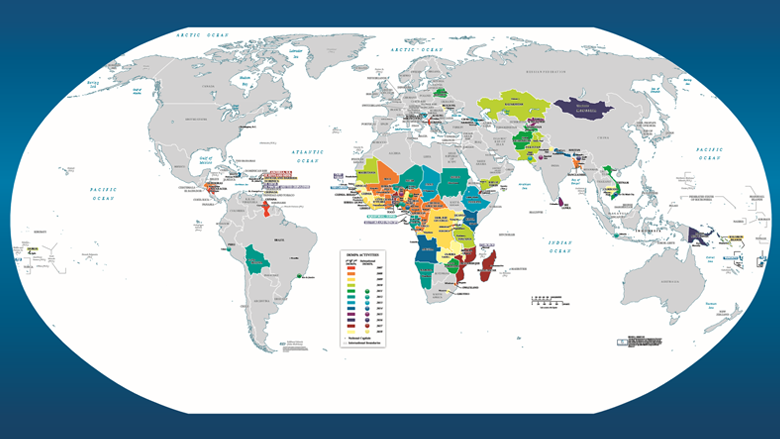Where DeMPA is used
Since its launch in 2007, the DeMPA has been used by more than 150 national and subnational governments.
See the map in high resolution here. DeMPA Framework
Sovereign DeMPA Methodology
The DeMPA is focused on central government debt management activities and closely related functions. It also helps to identify to what extent government-related entities and the central government coordinate their borrowing activities. The assessment’s scoring system evaluates 15 core indicators that are rooted in five fundamental pillars.
2021 Sovereign DeMPA Methodology | DeMPA Scoring Tables
Governance and Strategy Development: Governance is a cornerstone of the DeMPA, covering the legal structure that shapes and directs countries’ debt management processes. This includes coordination between a country’s legislative and executive branches to authorize borrowing, delegation of debt management responsibilities, and regular public disclosure of debt-related information to promote transparency and accountability.
Indicators included under this pillar:
- Legal Framework
- Managerial Structure
- Debt Management Strategy
- Debt Reporting and Evaluation
- Audit
Coordination with Macroeconomic Policies: The design and implementation of fiscal policy can have a big impact on the size and trajectory of public debt. Debt managers, fiscal policy advisers, and monetary policy authorities should have a shared understanding of goals spanning debt management, fiscal, and monetary policies—especially since these three areas have a diverse range of objectives and use different instruments to meet their respective goals. This coordination is critical to ensure the integrity and accountability of the institutions responsible for each policy area.
Indicators included under this pillar:
- Coordination with Fiscal Policy
- Coordination with Monetary Policy
Borrowing and Related Financing Activities: A government’s debt management strategy and annual borrowing plan are implemented through a range of financing activities, including domestic and external borrowing, loan guarantees, and derivatives. Due to the complexities inherent to these activities, debt management offices need employees with financial, operational, and legal expertise who understand the range of options available to countries, including how these borrowing sources operate and any constraints or risks that they may carry.
Indicators included under this pillar:
- Domestic Borrowing
- External Borrowing
- Loan Guarantees, On-Lending, and Derivatives
Cash Flow Forecasting and Cash Balance Management: In many low-income countries, the budget is not always reliable. Revenues are often overestimated, while important expenditures are underestimated.
Debt managers require reasonably reliable and timely forecasts of cash balances in government bank accounts to facilitate borrowing plans. Therefore, close coordination between debt and cash management activities is necessary to ensure there are always sufficient funds to meet the central government’s financial obligations, and that cash surpluses are managed in a safe and cost-effective manner.
Indicators included under this pillar:
- Cash Flow Forecasting and Cash Balance Management
Debt Recording and Operational Risk Management: Recording and monitoring debt management transactions are essential for ensuring accuracy of debt records and for detecting error and fraud. Payments processes must also include safeguards to ensure that they are timely and accurate. The effective use of the IT infrastructure, secure backups, and user-friendly IT systems in debt management offices can protect data and financial records and make it easier to maintain up-to-date records. In addition, electronic payments can further reduce the risk of errors.
Indicators included under this pillar:
- Debt Recording and Payments
- Data Access, Backups, and IT Infrastructure
- Debt-Related Records
- Debt Management Information Systems (DMIS) Use
Subnational DeMPA
The DeMPA is also used to analyze the strengths and weaknesses of debt management practices at the local level for subnational governments that have the capacity to incur debt, that plan to do so in the short-term, or have outstanding debt. The tools used for national and subnational assessments are similar, but the subnational DeMPA is tailored to address the needs of local entities, which differ from central banks.
Download the Subnational DeMPA Methodology

